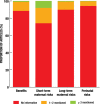What do popular Spanish women's magazines say about caesarean section? A 21-year survey
- PMID: 24467797
- PMCID: PMC4162994
- DOI: 10.1111/1471-0528.12513
What do popular Spanish women's magazines say about caesarean section? A 21-year survey
Abstract
Objectives: Caesarean section (CS) rates are increasing worldwide and maternal request is cited as one of the main reasons for this trend. Women's preferences for route of delivery are influenced by popular media, including magazines. We assessed the information on CS presented in Spanish women's magazines.
Design: Systematic review.
Setting: Women's magazines printed from 1989 to 2009 with the largest national distribution.
Sample: Articles with any information on CS.
Methods: Articles were selected, read and abstracted in duplicate. Sources of information, scientific accuracy, comprehensiveness and women's testimonials were objectively extracted using a content analysis form designed for this study.
Main outcome measures: Accuracy, comprehensiveness and sources of information.
Results: Most (67%) of the 1223 selected articles presented exclusively personal opinion/birth stories, 12% reported the potential benefits of CS, 26% mentioned the short-term and 10% mentioned the long-term maternal risks, and 6% highlighted the perinatal risks of CS. The most frequent short-term risks were the increased time for maternal recovery (n = 86), frustration/feelings of failure (n = 83) and increased post-surgical pain (n = 71). The most frequently cited long-term risks were uterine rupture (n = 57) and the need for another CS in any subsequent pregnancy (n = 42). Less than 5% of the selected articles reported that CS could increase the risks of infection (n = 53), haemorrhage (n = 31) or placenta praevia/accreta in future pregnancies (n = 6). The sources of information were not reported by 68% of the articles.
Conclusions: The portrayal of CS in Spanish women's magazines is not sufficiently comprehensive and does not provide adequate important information to help the readership to understand the real benefits and risks of this route of delivery.
Keywords: Caesarean section; Spain; medicine in literature; periodicals as topic; pregnancy.
© 2014 The Authors. BJOG An International Journal of Obstetrics and Gynaecology published by John Wiley & Sons Ltd on behalf of Royal College of Obstetricians and Gynaecologists.
Figures




Similar articles
-
Chewing gum for enhancing early recovery of bowel function after caesarean section.Cochrane Database Syst Rev. 2016 Oct 17;10(10):CD011562. doi: 10.1002/14651858.CD011562.pub2. Cochrane Database Syst Rev. 2016. PMID: 27747876 Free PMC article.
-
Indwelling bladder catheterisation as part of intraoperative and postoperative care for caesarean section.Cochrane Database Syst Rev. 2014 Apr 11;2014(4):CD010322. doi: 10.1002/14651858.CD010322.pub2. Cochrane Database Syst Rev. 2014. PMID: 24729285 Free PMC article.
-
Caesarean myomectomy in pregnant women with uterine fibroids.Cochrane Database Syst Rev. 2025 Jan 27;1(1):CD016119. doi: 10.1002/14651858.CD016119. Cochrane Database Syst Rev. 2025. PMID: 39868519
-
Induction of labour for improving birth outcomes for women at or beyond term.Cochrane Database Syst Rev. 2018 May 9;5(5):CD004945. doi: 10.1002/14651858.CD004945.pub4. Cochrane Database Syst Rev. 2018. Update in: Cochrane Database Syst Rev. 2020 Jul 15;7:CD004945. doi: 10.1002/14651858.CD004945.pub5. PMID: 29741208 Free PMC article. Updated.
-
Cell salvage for the management of postpartum haemorrhage.Cochrane Database Syst Rev. 2024 Dec 20;12(12):CD016120. doi: 10.1002/14651858.CD016120. Cochrane Database Syst Rev. 2024. PMID: 39704317
Cited by
-
Association between rates of caesarean section and maternal and neonatal mortality in the 21st century: a worldwide population-based ecological study with longitudinal data.BJOG. 2016 Apr;123(5):745-53. doi: 10.1111/1471-0528.13592. Epub 2015 Aug 24. BJOG. 2016. PMID: 26331389 Free PMC article.
-
The portrayal and perceptions of cesarean section in Mexican media Facebook pages: a mixed-methods study.Reprod Health. 2022 Feb 22;19(1):49. doi: 10.1186/s12978-022-01351-8. Reprod Health. 2022. PMID: 35193590 Free PMC article.
-
Comparing public health-related material in print and web page versions of legacy media.JAMIA Open. 2024 Oct 7;7(4):ooae104. doi: 10.1093/jamiaopen/ooae104. eCollection 2024 Dec. JAMIA Open. 2024. PMID: 39386067 Free PMC article.
-
Women's and communities' views of targeted educational interventions to reduce unnecessary caesarean section: a qualitative evidence synthesis.Reprod Health. 2018 Jul 24;15(1):130. doi: 10.1186/s12978-018-0570-z. Reprod Health. 2018. PMID: 30041661 Free PMC article.
-
What would reduce caesarean section rates?-Views from pregnant women and clinicians in Ireland.PLoS One. 2022 Apr 28;17(4):e0267465. doi: 10.1371/journal.pone.0267465. eCollection 2022. PLoS One. 2022. PMID: 35482745 Free PMC article.
References
-
- Appropriate technology for birth. Lancet. 1985;2:436–7. - PubMed
-
- Betran AP, Merialdi M, Lauer JA, Bing-Shun W, Thomas J, Van LP, et al. Rates of caesarean section: analysis of global, regional and national estimates. Paediatr Perinat Epidemiol. 2007;21:98–113. - PubMed
-
- Cyr RM. Myth of the ideal cesarean section rate: commentary and historic perspective. Am J Obstet Gynecol. 2006;194:932–6. - PubMed
-
- De Brouwere V, Dubourg D, Richard F, Van LW. Need for caesarean sections in west Africa. Lancet. 2002;359:974–5. - PubMed
-
- Dumont A, de Bernis L, Bouvier-Colle MH, Breart G. Caesarean section rate for maternal indication in sub-Saharan Africa: a systematic review. Lancet. 2001;358:1328–33. - PubMed
Publication types
MeSH terms
Grants and funding
LinkOut - more resources
Full Text Sources
Other Literature Sources
Medical

